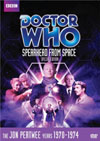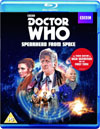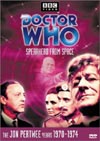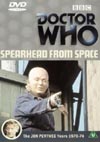Spearhead From Space
 |
 |
 |
 |
DVD NTSC
Region 1
Special Edition




|
DVD PAL
Region 2
Box set with
Special Edition


|
Blu-ray Region A/1
Companion Edition




|
Blu-ray Region B/2
Companion Edition


|
|
(Doctor Who Story No. 51, starring Jon Pertwee)
- written by Robert Holmes
- directed by Derek Martinus
- produced by Derrick Sherwin
- music by Dudley Simpson
- 4 episodes @ 25 minutes each
|
Story: A disabled TARDIS strands the newly regenerated
Doctor on Earth in the early 1970's, where his alien nature
is subjected to medical scrutiny at a country hospital.
He soon teams up with Brigadier Lethbridge-Stewart of U.N.I.T.,
and investigates some unusual showers of artificial meteorites.
What is the connection between these objects and the bizarre
living mannequins called Autons that are determined to protect
them with deadly force?
|
|
This is the only TV story shot completely on film
(as opposed to the usual video tape with a few location film inserts).
No real surprise that it's coming to Blu-ray. Whether or not there's
enough picture detail on any other classic Doctor Who TV source material
to justify a Blu-ray transfer is unclear....
Special Edition Standard DVD Extras (NONE of which are on the blu-ray version!) include:
- Audio commentary by actors Nicholas Courtney (The Brigadier)
and Caroline John (Liz Shaw).
- Audio commentary by producer Derrick Sherwin and
script editor Terrance Dicks.
- "Down to Earth" making-of featurette (23 min.) with Sherwin, Dicks,
Jon Pertwee (The Doctor),
incoming producer Barry Letts,
assistant script editor Robin Squire (Auton), and
costume designer Christine Rawlins.
- "From BW to Colour" featurette (19 min.), with Sherwin, Dicks,
graphic designer Bernard Lodge,
Frazer Hines (Jamie),
Wendy Padbury (Zoe),
"War Games" designer Roger Cheveley, and
series directors Tim Combe, Chris Barry, and Michael Ferguson.
- U.N.I.T. recruitment film (5 min., 1993)
- Pop-up Production Note Subtitles
- Photo Gallery sound effects montage (4 min.)
- Trailers (2 min.)
- Easter Egg (1 min.)
Blu-ray Extras include:
- Jon Pertwee biography documentary (42 min.) including Terrance Dicks and Katy Manning (Jo Grant)
- Caroline John tribute (29 min.) including husband Geoffrey Beevers (Melkur / Private Johnson)
- Title Sequence Material (23 min.) raw silent footage
- Restoration featurette (2 min.)
In-Depth Analysis Review
by Martin Izsak
|
|
WARNING: This review contains "SPOILERS", and is intended for
those who have already seen the program. To avoid the spoilers,
read the Buyers' Guide version instead.
|
The Jon Pertwee Era opens up with an interesting, tightly-paced
story that neatly captures the essence of Doctor Who, monster stories,
and the UNIT era in particular. It doesn't do too badly as a
surrogate pilot story for the program, possibly the best any Doctor
after Hartnell ever started out with, but it still misses a few
important marks.
Filmed in Colour
Colour splashes boldly onto the screen with a new title
sequence and new version of the theme song, both of which are
extremely satisfying. Further improvement to the graphics might have
included a moving background continuing behind Jon Pertwee's face
after it solidifies clearly, so that it and the finished title
logo might spend more time on screen being legible and recognizable,
and less time in flux. The theme song now wisely spends less time
on its introductory bars and more time on the signature portions of the
melody, portions that often did not get their due when the previous
titles faded early to specially prepared opening sequences for
individual stories.
This is not the first colour Doctor Who production, however.
Due to a studio scenery workers strike, the whole story was shot
on film on location, giving it a look extremely close to previous
Peter Cushing Dalek films. "Spearhead From Space" easily surpasses
"Dr. Who and the Daleks"
(remake of story no. 2)
in quality, but
"Daleks' Invasion Earth 2150"
(remake of story no. 10)
manages to hold together a bit better in my view.
Surrogate Pilot Story
The Doctor's entrance is not all that it should be. Episode One
is full of short snippets of different characters in different
locations doing different things, and they are not all linked up
as effectively as they could be. Early scenes of the Doctor are
the most disjointed of the bunch. I have no complaints about the
actual footage, or the basic idea that Robert Holmes and Terrance
Dicks came up with in not showing much of the Doctor at first and
revealing him very slowly - that's great and, in itself, that idea
works. It's the surrounding material, however, that fails to support
it. The poor frightened, sweating chap manning the radar raises
a question: "I suppose they must have been meteorites, mustn't they?"
The camera has moved in on him, indicating how important a question
it is. Unless that question is deflected, the next shot will have
the aura of trying to answer it cinematically. As originally edited,
"Spearhead From Space" answers that question with: "No it wasn't
meteorites, it was a police box popping out of nowhere with a man
falling out of it." Before any sense can be made of that quick clip,
we shift to see lots of an unfamiliar woman cruising through a city
in the back seat of a car, not looking very happy despite the
accompanying mellow tones on the soundtrack. First time
viewers of "Doctor Who" may justifiably be wondering what
the heck this is all about at this point. One quick fix that
comes to mind is to first deflect the question from the radar scene,
and adapt it properly to what follows. Let the female UNIT officer
answer the radar operator with something like "With so many small
governments pushing their limited technology into the space race,
you never know what's going to fall from the sky next these days."
Now the stage is set for the arrival of the TARDIS, a new and wondrous
something IN ADDITION to the odd meteorites, with a sense of mystery
surrounding it. And don't rush its entrance either. Build it up with
some music. Let the materialization take its time; play the model
footage at half-speed if necessary. The sound effect is still
passable when played in the wrong direction, but unfortunately its
cue sounds fumbled, as it hurriedly winds up from zero to normal
speed at full volume, instead of fading up its volume like usual.
A similar fumble later throws the title music out of sync with the
graphics, until there isn't any music left to cover the curiously
absent "episode two" caption (now cleaned up for the recent DVD releases).
Things like this made the production seem hurried and sloppy.
The Doctor's second scene, being covered up and hauled through
a hospital on a stretcher while Captain Munro and Dr. Henderson talk
about him, is equally out of place in the meteorite investigation that
drives episode one's first story beat. The Doctor's first two scenes,
however, complement each other beautifully when they are juxtaposed
back to back, and fit most logically into the flow of the story when
squeezed between the Brigadier's reminisces of who the Doctor was
and the interruption of Munro's phone call immediately after. One
factor aiding this re-timing of events is that the costly night-shooting
Robert Holmes wanted was abandoned, and everything now happens in the
day when things can be shuffled less noticeably. A pity that the
dialogue wasn't altered to remain consistent with day-shooting as well.
At any rate, these are fairly minor points that affect the
assessment of the adventure as "pilot story" material more than
anything else. Regular and casual viewers familiar with Doctor Who
should have
little trouble following everything. With the new Doctor being revealed
slowly, Brigadier Lethbridge-Stewart is called upon to carry the
story for most of the first two episodes, being the only familiar
face left on the show even though his character only made two previous
guest appearances. Nicholas Courtney does the job superbly; the
Brigadier is enormously enjoyable as usual, refreshingly open-minded
towards fantastic scientific theories and even arguing in favour
of them with Cambridge researchers to boot! Caroline John does
a nice job of Liz Shaw, spending most of her time as a foil for
the Brigadier or the Doctor, where she is at her best.
The slow-revelation of the Doctor works best as the Brigadier
becomes intrigued and decides to investigate and take precautionary
measures, effectively shifting the story onto this new beat. The
Doctor's alien nature is finally given its due in this story, as his
double-hearted, alien-blood-type physiology is definitively revealed.
Only after the Brigadier gets a good look at the Jon Pertwee version
of the Doctor do the rest of the audience, and the Doctor himself,
get to see him properly as well. Many of the old Patrick Troughton
sneaky and mischievous mannerisms are apparent in this initial
performance, and even though Pertwee's tall form is not quite as suited
to getting away with them as Troughton's was, they are still a logical
and enjoyable continuity link. New Pertwee mannerisms are taking root,
and will solidify in the following stories as the actor plays the role
even straighter and more seriously. The mutual seeking out of actor
and producer as the role of the Doctor was cast seems like an
inevitable act of providence. Jon Pertwee is the Doctor, from day one.
"Spearhead From Space" contains many borrowed ideas. The Autons
parallel the Yeti, the meteorites parallel their control spheres, and
the Nestene parallels the Great Intelligence, giving the Brigadier
and UNIT very healthy chances of recapturing their earlier appeal
from previous Doctor Who stories, showcasing the dynamics of what
they are all about and what they are needed to protect us from.
Also, Holmes borrowed a lot of ideas from previous sci-fi stories
that he liked, meteorites bringing danger, threatening abnormalities
in factories being covered up, etc. It might not be all that
original, but who cares? Holmes makes the Autons his own creation,
gives us a definitive version of these sci-fi dynamics in colour,
all while advancing Doctor Who mythology through into a new format.
His version now vies for position as the best, most classic of the lot.
Man of Action / Man of Sleep
Jon Pertwee's Doctor is often referred to as the "Man of Action"
in Who literature, but many single half-hour episodes seem to contradict
this by showing him flaked out on a bed for most of his screen time,
either unconscious, semi-conscious, generally lacking in energy,
or just plain lounging around. "Man of Sleep" is often a more
appropriate epithet. He certainly gives us a good dose of that
at the beginning of his era in the first half of this story, but
I'll let my criticism be a little lenient this time, as he has
a forced regeneration to recover from, and all this sack-hitting is
a far cry above the "missing Doctor" episodes of the sixties, but
the "friendly fire" incident, with concussion and coma to follow,
was probably not
the best scripting move. To be fair, Jon Pertwee's Doctor takes
command of the story as he arrives in UNIT HQ late in the second
episode, and from then on, it really is his story. He gets lots of
screen time and gets plenty to do, leading the investigations and the
problem solving, and he is every bit the hero capable of diplomatic
charm as well as an integral role in the action. This excellent
high-profile later on beautifully makes up for his initial napping.
Good job.
Although the Doctor explains all about the TARDIS, including
the fact that it is dimensionally-transcendental and what-not,
a scene or two in the interior is an essential missing element,
probably best placed in episode three close to where he tries to
make his get-away. This story can still work excellently without it,
but it unfortunately doesn't make as great a pilot for the entire
series or the later Pertwee era that way. Even just on its own,
being able to show something always works better cinematically and
leaves a greater impression on the audience than just talking about
it in the dialogue.
Dudley Simpson's music is quite tasteful this time around, using a
partially thematic approach that makes it more memorable than usual.
Most of it is quite effective, and even when it isn't, it's still
interesting listening material.
Some of the more suspenseful scenes seem a little hammy in the
way they were directed, particularly the facial reaction close-ups.
They too often center on the person's line of sight, throwing them
out of joint with the rest of the sequences they are edited into.
The episode endings are not great, but will do. Episode two's
cliffhanger really should have included the revelation of the
Auton's gun-hand, as this creates even more horror and helps the
cliffhanger retain more of a threat on repeat viewing, especially
as we've already seen blue-collar Autons walking around causing UNIT
jeeps to crash into trees with fatal results.
The supporting actors do a fairly good job in this one, although
the performances never really shout for attention. Captain Munro
and Dr. Henderson are superb throughout in giving minimal,
underplayed performances; they and Meg Seeley always appear totally
believable. Hugh Burden is successful in making Channing very weird
and mysterious, and John Woodnutt playing Hibbert and Derek Smee playing
Ransome give great performances when playing straight scenes, but when
they have to be frightened or mad, the directing lets them down a bit,
and they come off looking a little silly.
Martinus does better in directing the action scenes, which work
quite well this time around. Liz is instrumental in delivering the
final blow, but the Doctor does not get upstaged as he is very busy
himself and generally takes many more risks leading the charge and
in making sure the job gets done.
The story manages to conclude on a high and humorous note, as
some of the perks and conditions of the new exile format for the
show are decided and laid out in the final scene. The versions
of the theme music for the credits in this story are unique,
cross-fading to portions of itself that rarely get aired
on any other stories.
All in all, "Spearhead From Space" has
been quite a success. Season Seven continues to be packed with such
quality material however, that this opening four-parter may end up
last in the list of season favourites anyway, a posting it should
not take too hard. There are no Wooden Turkey Awards to be given
out this season.
International Titles:
Deutsch (German): (Autons: Der erste Angriffswelle)
Magyar (Hungarian): "Lándzsahegy az űrből"
Français (French): (Fer de lances venu de l'espace)
Русский (Russian): "Острие из космоса"
English Novelization: "The Auton Invasion"
Titles rarely vary much during this time from one language to another.
Much bigger variation can be found on many titles for the official novelizations,
and of those, "The Auton Invasion" is one of the more sensible ones.
This story has become available on DVD and VHS video.
New Special Edition release:
|
 |
 |

with minimal extras. |

with minimal extras. |
DVD NTSC Region 1
Special Edition
for the North American market:

 in the U.S.
in the U.S.

 in Canada
in Canada
NEW for Aug. 14, 2012.
|
DVD PAL Region 2
Box set with Special Edition

 for the U.K.
for the U.K.
|
Blu-ray Region A/1
Companion Edition
 in the U.S. in the U.S.

 in Canada in Canada

NEW for Aug. 13, 2013
with minimal extras.
|
Blu-ray Region B/2
Companion Edition
 for the U.K. for the U.K.

NEW for July 15, 2013
with minimal extras.
|
Original release:
|
 |
 |
DVD NTSC Region 1
for the North American market:

 in the U.S.
in the U.S.

 in Canada
in Canada |
DVD PAL Region 2

 for the U.K.
for the U.K. |
|
Original DVD Extras include:
- Audio commentary by actors Nicholas Courtney (The Brigadier)
and
Caroline John (Liz Shaw).
- U.N.I.T. recruitment film (5 min.)
- Pop-up Production Note Subtitles
- Photo Gallery
- Trailers (2 min.)
- Easter Egg (1 min.)
- "Who's Who" actor biographies (text only,
may appear on Region 1 discs only)
|
 |
VHS Video
NTSC
 A A
 U.S.
U.S.
NTSC
 B B
 U.S.
U.S.
NTSC
 A A
 Canada
Canada
NTSC
 B B
 Canada
Canada
PAL

 U.K.
U.K.
|
|
Comments on this article are welcome. You may contact
the author from this page:
Contact page

LYRATEK.COM
|
Read the In-depth Analysis Review for the next story:
"The Silurians"

|
|















